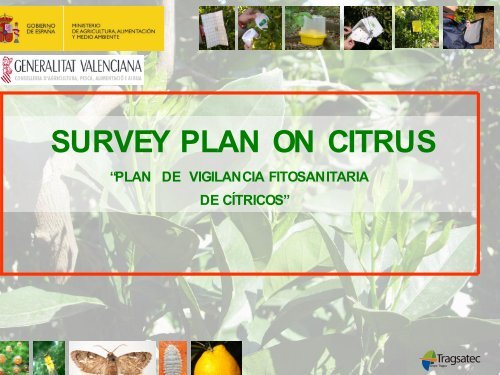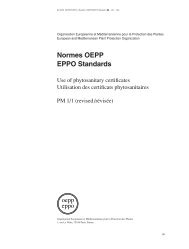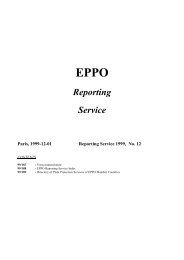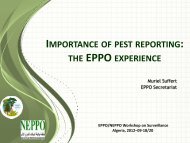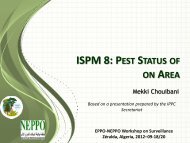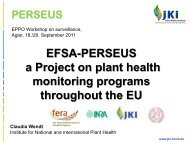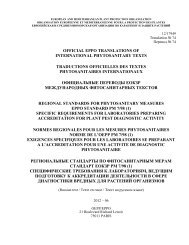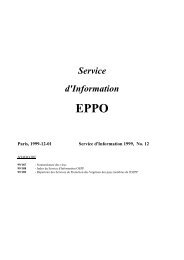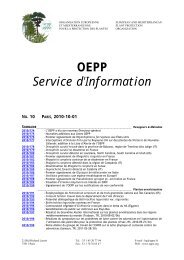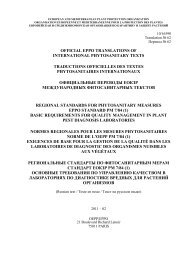Citrus orchard surveillance program - Lists of EPPO Standards
Citrus orchard surveillance program - Lists of EPPO Standards
Citrus orchard surveillance program - Lists of EPPO Standards
Create successful ePaper yourself
Turn your PDF publications into a flip-book with our unique Google optimized e-Paper software.
SURVEY PLAN ON CITRUS<br />
“PLAN DE VIGILANCIA FITOSANITARIA<br />
DE CÍTRICOS”
ACCORDING TO ISPM Nº 6<br />
A survey Plan must content:<br />
• Definition <strong>of</strong> the purpose (Early detection)<br />
• Identification <strong>of</strong> target pests (Alert list)<br />
• Identification <strong>of</strong> the scope (Valencia Region)<br />
• Identification <strong>of</strong> the timing (W eekly, less <strong>of</strong>ten in winter)<br />
• Identification <strong>of</strong> the target commodity (<strong>Citrus</strong>)<br />
• Statistical basis (M easure <strong>of</strong> the Survey)<br />
• Survey methodology (adapted to each pest)<br />
• Diagnostic procedures (adapted to each pest)<br />
• Report procedures (W EB and <strong>of</strong>ficial reports)<br />
PLAN DE VIGILANCIA FITOSANITARIA
1.- OBJETIVES<br />
2.- PRELIM INARY W ORK<br />
2.1.- Alert list<br />
2.2.- Find Available & most suitable traps and attractants<br />
2.3.- Find &/or design monitoring & sampling systems<br />
2.4.- Find &/or design symplified keys for recognition<br />
2.5.- Elaborate a “Procedures Manual”<br />
2.6.- Surveillance design & measure<br />
3.- ACTIVITIES:<br />
PLAN DE VIGILANCIA FITOSANITARIA DE CÍTRICOS<br />
3.1.- Quarantine pests trapping & sampling<br />
3.2.- Common pests monitoring. Aonidiella aurantii populations monitoring<br />
3.3.- General information about main pest in the crop
2.- PRELIMINARY WORK<br />
2.1.- Alert list<br />
Aleurocanthus spiniferus<br />
Aleurocanthus woglumi<br />
Anastrepha fraterculus<br />
Anastrepha ludens<br />
Anastrepha obliqua<br />
Anastrepha suspensa<br />
Aonidiella citrina<br />
Aonidiella orientalis<br />
Bactrocera dorsalis<br />
Bactrocera tsuneonis<br />
Bactrocera zonata<br />
Ceratalaspis cosyra<br />
Ceratalaspis quinaria<br />
Ceratitis (Pterandrus) rosa<br />
Chrysomphalus aonidum<br />
Coccus viridis<br />
Crytophlebia leucotreta<br />
Diaphorina citri<br />
Ecdytolopha aurantiana<br />
Eotetranychus lewisi<br />
Eutetranychus banksi<br />
Eutetranychus orientalis<br />
Leucaspis japonica<br />
Orthezia praelonga<br />
Paraleyrodes bondari<br />
Paraleyrodes citri<br />
Saissetia (Parasaissetia) nigra<br />
Scirtothrips aurantii<br />
Scirtothrips citri<br />
Scirtothrips dorsalis<br />
Selenaspidus articulatus<br />
Toxoptera citricidus<br />
Tryoza erytreae<br />
Unaspis citri<br />
Unaspis yanonensis
2.- PRELIMINARY WORK<br />
2.1.- Alert list<br />
<strong>Citrus</strong> greening bacterium<br />
<strong>Citrus</strong> variegated clorosis<br />
Deuterophoma tracheiphilla<br />
Elsinoe fawcettii<br />
Guignardia citricarpa<br />
Phaeoramularia angolensis<br />
Xanthomonas campestris<br />
<strong>Citrus</strong> blight diseases<br />
<strong>Citrus</strong> leprosis rhabdovirus<br />
<strong>Citrus</strong> tatter leaf capillovirus<br />
<strong>Citrus</strong> tristeza closterovirus<br />
Lime witches’ broom<br />
Satsuma dwarf nepovirus
2.- PRELIMINARY WORK<br />
2.2.- Find Available & most suitable traps and attractants
2.- PRELIMINARY WORK<br />
2.3.- Find or design monitoring & sampling systems
For each control area:<br />
Two main tasks:<br />
PM 1<br />
PM 2<br />
PF<br />
PM 3<br />
PM 4<br />
4 aleatory sampling<br />
(PM) & 1 fixed (PF) +<br />
+<br />
PEC2<br />
PEC1<br />
PLAN DE VIGILANCIA FITOSANITARIA<br />
PEC3<br />
Additionally all the<br />
Estrategic points (PEC)<br />
1 - Visul inspections for quarantine and common pests in (PM ) & (PFS).<br />
2 - M aintenance <strong>of</strong> traps for quarantine pests (PF) & (PEC)
2.- PRELIMINARY WORK<br />
2.4.- Find or design symplified keys for recognition<br />
Bactrocera<br />
Anastrepha Ceratitis
2.- PRELIMINARY WORK<br />
2.5.- Elaborate a Procedure Manual<br />
How to maintain the traps?<br />
What to look for in each trap?<br />
How to recognize each pest?<br />
How to sample each different pest?<br />
How common pest looks like?<br />
How can we distinguish common<br />
pest from quarantine ones?<br />
How to preserve and transport<br />
samples?<br />
How to record and report the info<br />
gathered?<br />
WHAT IS THE PROCEDURE TO<br />
FOLLOW IN CASE OF A<br />
QUARANTINE PEST DETECTION?
2.- PRELIM INARY W ORK<br />
2.6.- Surveillance design and measure<br />
The whole citrus sur face 1 8 0 .0 0 0 ha<br />
was divided in 1 0 0 control areas:<br />
- 2 0 in Castellón,<br />
- 6 0 in Valencia<br />
- 2 0 In Alicante.<br />
In each control area there is fixed plot<br />
were the traps are placed<br />
PLAN DE VIGILANCIA FITOSANITARIA DE CÍTRICOS<br />
DISTRIBUTION IN<br />
CONTROL AREAS
2.- PRELIMINARY WORK<br />
2.6.- Surveillance design and measure
2.- PRELIMINARY WORK<br />
2.6.- Surveillance design and measure<br />
1 1 7 traps batteries in the following points:<br />
- 100 (Fixed <strong>orchard</strong>s).<br />
- 17 (Strategic points: points <strong>of</strong> entr y, warehouses, etc.).<br />
All captures are indentified in the lab<br />
PLAN DE VIGILANCIA FITOSANITARIA
Strategic points:<br />
• Airpor ts: Alicante & Valencia.<br />
• Por ts: Gandía, Valencia & Castellón.<br />
• Farms and livestocks where citrus are used: 4<br />
PLAN DE VIGILANCIA FITOSANITARIA<br />
• Warehouses where citrus impor ted from third countries are<br />
processed (sor ting, re.packing, etc.): 8
QUARANTINE TRAPS:<br />
Trap Attractant Target Pest<br />
Delta M ethyl Eugenol<br />
Delta<br />
Cuelure<br />
Tephrítids<br />
Genus Bactrocera sp.<br />
(some species)<br />
Tephrítids<br />
Genus Bactrocera sp.<br />
(some species)<br />
Delta<br />
Terpenil Acetate Tephrítids<br />
Subgenus<br />
Ceratalaspis sp.<br />
& Pterandrus sp.<br />
M c Phail Torula yeast Tephrítids<br />
Genus Anastrepha sp.<br />
Nadel Trimedlure &<br />
Vapona<br />
Tephrítids<br />
Genus Ceratitis sp.<br />
PLAN DE VIGILANCIA FITOSANITARIA
QUARANTINE TRAPS:<br />
Yellow sticky<br />
trap<br />
Delta<br />
Delta<br />
Trap Attractant<br />
-------<br />
Specific<br />
pheromon<br />
e<br />
Specific<br />
pheromon<br />
e<br />
Target insect<br />
Psyllidae, thysanoptera,<br />
cicadellidae<br />
Ecdytolopha<br />
aurantiana<br />
Cr yptophlebia<br />
(=Thaumatotibia)<br />
leucotreta<br />
PLAN DE VIGILANCIA FITOSANITARIA
COM M ON PEST TRAPS<br />
Sticky white<br />
card<br />
Sticky white<br />
card<br />
Delta<br />
Funnel<br />
(Only South<br />
Alicante)<br />
Trap Attractant Target insect<br />
Specific<br />
pheromone<br />
Specific<br />
pheromone<br />
Specific<br />
pheromone<br />
Specific<br />
pheromone<br />
+ vapone<br />
California red scale<br />
(Aonidiella aurantii)<br />
<strong>Citrus</strong> mealybug<br />
(Planococcus citri)<br />
<strong>Citrus</strong> leafminer<br />
(Phyllocnistis<br />
citrella)<br />
<strong>Citrus</strong> flower moth<br />
(Prays citri)<br />
PLAN DE VIGILANCIA FITOSANITARIA
3.- ACTIVITIES<br />
3.1.- Quarantine pests trappping & sampling<br />
The following par ts are obser ved:<br />
2 flower buds,<br />
2 flowers,<br />
2 fruits,<br />
1 tender shoot,<br />
1 shoot, branch, leave & trunk.<br />
Obser vations are noted and recorded in the database<br />
Doubts are sent to the lab<br />
PLAN DE VIGILANCIA FITOSANITARIA
IN CASE OF DETECTION<br />
If the pest is confirmed by the lab:<br />
- If specific attractant exists 3 7 traps are placed<br />
per km 2 distributes as in the figure.<br />
Weekly revided. Depending on the result the<br />
Area is broaden or the frequency <strong>of</strong> revisions<br />
is reduced<br />
PLAN DE VIGILANCIA FITOSANITARIA<br />
- If no specific attractant exists visual inspections in all the continuos citrus <strong>orchard</strong>s<br />
until extension is delimited<br />
500 m<br />
250 m<br />
100 m<br />
50 m<br />
25 m<br />
0<br />
TRAP
2 .2 .- California red scale monitoring<br />
The aim is to inform to stakeholders <strong>of</strong> the better moment<br />
for treatment. M onitoring <strong>of</strong> the different stages <strong>of</strong> the<br />
California red scale (Aonidiella aurantii)<br />
Crawler stage monitoring, monitoring <strong>of</strong> males and<br />
acumulated degrees days to predict the maximum <strong>of</strong><br />
(L1 +L2 ).<br />
PLAN DE VIGILANCIA FITOSANITARIA DE CÍTRICOS
PLAN DE VIGILANCIA FITOSANITARIA DE CÍTRICOS
W EB INFORM ATION<br />
PLAN DE VIGILANCIA FITOSANITARIA DE CITRICOS
Spatial distribution <strong>of</strong> the main pests<br />
PLAN DE VIGILANCIA FITOSANITARIA DE CITRICOS<br />
Poblacional evolution compared with<br />
previous years <strong>of</strong> the main pests
Results<br />
First records in the Valencia Region <strong>of</strong>:<br />
• Coccus pseudomagnoliarum<br />
– Detected in 2005.<br />
– Distribution delimited<br />
– Not relevant<br />
• Anatrachyntis badia<br />
– Detected in 2006.<br />
– Not relevant as a pest<br />
• Pezothrips kellyanus<br />
– Detected in 2007.<br />
– Distribution delimited
THANK YOU VERY M UCH FOR<br />
YOUR ATTENTION


